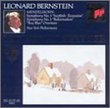| All Artists: Paul Hindemith, Leonard Bernstein, New York Philharmonic Title: Hindemith: Symphony in E flat, Symphonic Metamorphoses; Konzertmusik, Op. 50 Members Wishing: 0 Total Copies: 0 Label: Sony Original Release Date: 1/1/1992 Re-Release Date: 11/17/1992 Genre: Classical Styles: Historical Periods, Modern, 20th, & 21st Century, Symphonies Number of Discs: 1 SwapaCD Credits: 1 UPC: 074644756623 |
Search - Paul Hindemith, Leonard Bernstein, New York Philharmonic :: Hindemith: Symphony in E flat, Symphonic Metamorphoses; Konzertmusik, Op. 50
 | Paul Hindemith, Leonard Bernstein, New York Philharmonic Hindemith: Symphony in E flat, Symphonic Metamorphoses; Konzertmusik, Op. 50 Genre: Classical
|
Larger Image |
CD DetailsSimilar CDs
|
CD ReviewsDisappointing sibrwulf | 12/21/2002 (2 out of 5 stars) "I have also played some of these works and know that the brass section in these recordings just aren't characteristic fo the NY Phil. They tongue extremely hard on areas that are supposed to light or chorale-like and it ruins the music. Also, some of the interpretations in the Symphonic Metamorphosis are quite contrary to the style of the piece. This recording just isn't the one you are looking for. The one you are looking for is the London Symphony recording with Abbado on a DECCA or LONDON label. That is the one to get." Rousing Performances by Leonard Bernstein D. A Wend | Buffalo Grove, IL USA | 04/04/2007 (5 out of 5 stars) "The Symphony in E flat was written in 1940 when Paul Hindemith had gone into exile in the United States and taught at Tanglewood at Serge Koussevitzky's invitation. The symphony was written for the Boston Symphony from a commission by Koussevitzky and the premiere took place on November 21 by the Minneapolis Symphony conducted by Dmitri Mitropoulos. The symphony is among the composer's most approachable works and, like the later Symphonic Metamorphosis brims over with energy and interesting melodies. The symphony is in four movements, beginning with a rousing fanfare for brass and goes into a stirring, heroic melody played by the strings with the brass carrying the melody to its climax. The short movement continues with the strings and brass passing the theme back and forth with a brief trio for woodwinds before the brass brings the music to a triumphant conclusion. The second movement begins with a march-like melody for the trumpets and carries on with a brooding, reflective section for the strings and woodwinds, occasionally interrupted by the brass. The third movement begins energetically and has a lovely trio section where the woodwinds trade the melody to a dreamy orchestral accompaniment before returning to the throbbing drum rhythm. The third and fourth movements are thematically connected and the orchestra does not pause. The fourth movement is like a concerto for orchestra with sections of the orchestra demonstrating their virtuosity. An intermezzo section has the woodwinds trading a melody back and forth before the full orchestra joins them in a return to the rousing, march-like music of the first movement. There is a reflective section carried by the strings that are mournful which changes to the march melody. The music slowly builds in intensity to the final restatement of the theme and the symphony ends in a glorious fanfare for the brass. The Symphonic Metamorphosis was written in 1943 and was first performed in New York on January 20,1944, conducted by Artur Rodzinsky; it is probably Hindemith's most popular works with each movement based on themes by Carl Maria von Weber, including music from Turandot and piano trios. The music in inventive and colorful and began as a possible ballet for Leonide Massine. Cast in four movements the symphony brims with inventive and rousing melodies. The second movement is a scherzo based on a melody from Turandot which is expressed less as an oriental melody and is inventively stretched into many different variations and is followed by a lovely slow movement with soaring themes; the symphony ends with a boisterous movement announced by the brass and developed by the strings and woodwinds with exclamations by brass and tympani. The symphony ends triumphantly with fanfare calls by the brass. The Concert Music for String Orchestra and Brass was the last work that Paul Hindemith assigned an opus number and was written in 1930. The work was commissioned for the 50th anniversary of the Boston Symphony and is in two parts. The brass section of the Boston Symphony was particularly renowned so the composer scored this work for twelve brass players (four horns, four trumpets, three trombones and a bass tuba). The brass dominates the first of the first part the second part is characterized by soaring melodies for the strings, punctuated by the brass. This recording by Leonard Bernstein from 1967 is arguably the best recording of the Symphony in E-flat. The final bars of the symphony are positively exciting and have not been equaled. I owned the original LP and was happy to see the performance transferred to CD. Although Maestro Bernstein recorded the Symphonic Metamorphosis and Concert Music in subsequent years I do not thing they are better performed than in these recordings from the 1960's. The sound is certainly good, perhaps not up to audiophile standards but certainly excellent. " Superb performance of magnificent music sibrwulf | Texas | 04/26/1999 (5 out of 5 stars) "I am a Tuba player and have performed some of these pieces and think that the recording quality is stupendous. It gave me goosebumps"
|

 Track Listings (14) - Disc #1
Track Listings (14) - Disc #1



